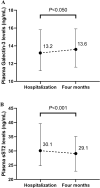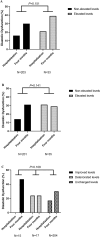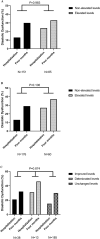Association of fibrotic markers with diastolic function after STEMI
- PMID: 39155333
- PMCID: PMC11330983
- DOI: 10.1038/s41598-024-69926-y
Association of fibrotic markers with diastolic function after STEMI
Abstract
Galectin-3 and Suppression of tumorigenicity-2 (ST2) are known markers of cardiac fibrosis. We investigated the prognostic value of fibrotic markers for the development of diastolic dysfunction and long-term outcome in patients suffering an ST-elevated myocardial infarction (STEMI). We analyzed 236 patients from the GIPS-III cohort with available echocardiographic studies and plasma measurements at hospitalization and after 4 months follow-up. Adjusted logistic mixed effects modelling revealed no association between the occurrence of diastolic dysfunction over time with abnormal plasma levels of galectin-3 and ST2. We observed no differences regarding survival outcome at follow-up of 5 years between patients with normal versus abnormal values in both galectin-3 (P = 0.75), and ST2 (P = 0.85). In conclusion, galectin-3 and sST2 were not associated with the development of diastolic dysfunction in non-diabetic patients that presented with a STEMI.
© 2024. The Author(s).
Conflict of interest statement
The authors declare no competing interests.
Figures




References
MeSH terms
Substances
Grants and funding
LinkOut - more resources
Full Text Sources

